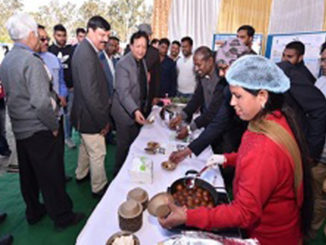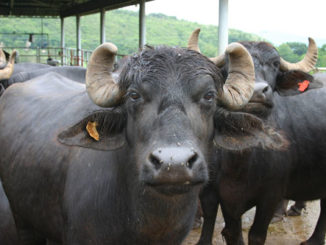Introduction
Diarrhoea is one of the common digestive disorders in bovines of all age groups causing heavy economic losses to dairy industry due to mortality in neonates and losses in terms of production and reproduction in adult dairy animals. Various infectious agents including bacteria, viruses and parasites cause diarrhoea in farm animals. Diarrhoea may be self-limiting in a few cases but may cause high morbidity and mortality [1]. E. coli is often attributed to calf scours and clinically complicated by other microbes like Proteus spp. and Pseudomonas spp. [2]. Salmonella also affects calves especially kept under intensive system of husbandry [3]. Rotavirus, Corona virus and Cryptosporidium spp. are capable of causing diarrhoea in young calves [4]. In buffaloes, Salmonella is a major pathogen causing calf diarrhoea leading to early age calf-mortality [1]. Extensive work on diarrhoea in adult buffaloes has not been done.
Materials and Methods
The present study was conducted in 40 clinical cases of non-responding diarrhoeic murrah buffaloes. History included appetite, water intake, milk yield, duration of illness, frequency of defaecation, appearance of faeces and its abnormal contents etc. Clinical observations included rectal temperature, pulse rate, respiration rate, appearance of mucous membranes and ruminal movements.
Collection of samples for biochemical examination
Blood sample was collected from these animals aseptically using clot activator sterile vials and serum was separated by centrifugation at 3000 rpm for 7 min. These serum samples were used for analysis of Na, K, Cl, Ca, Pi, Mg. Parameters were estimated before start of treatment and after five day of treatment.
Therapeutic studies
These cases had already been treated by local veterinarians by administering dewormers and astringent powders etc. Evaluation of therapeutic efficacy of Ceftriaxone along with Lugol’s iodine in the treatment of these clinical cases of diarrhoea in buffaloes was done. The diagnosis was based on clinical signs, haemato-biochemical findings (leuckocytosis with neutrophilia) and faecal examination for endoparasites. Clinical, haematological and biochemical parameters were also studied pre-treatment (day 0) and after five days of treatment (day 5). For therapeutic studies, the clinical cases of diarrhoea were sub-divided into 3 groups. Group 1 – (n = 6) Healthy control, Group 2 – (n = 6) Antibiotic (Ceftriaxone) + metronidazole + supportive treatment and Group 3 – (n=32) Antibiotic (Ceftriaxone) + metronidazole + Lugol’s iodine + supportive treatment. Ceftriaxone was administered @ 8 mg/kg bwt im od x 5 d. Metronidazole was administered @ 20 mg/kg bwt iv od x 5 d. Lugol’s iodine [5] was administered @ 15 ml in 500 ml of NS slow iv od × 5d. NSAID- a poly herbal preparation (bolus Rumalya, M/s Himalyan Drugs) 2 po bid x 5 d. Inj. ascorbic acid @ 7.5 g sc od x 5 d. pulv. A polyherbal antidiarrhoeal preparation (pulv. Diaroak M/s Ayurvet) @ 30 g po od/adult animal x 3 d. Fluid therapy (Ringer’s Lactate) 4 L iv od x 5 d.
Statistical Analysis and Results interpretation
Data were expressed as mean (±standard error of the mean) and analysed by applying independent Student’s t-test using SPSS statistical software. Results were interpreted by improvement in clinical findings and follow up was done for 30 days to judge the cure rate.
Results
Buffaloes (n=40) suffering from non-responding diarrhoea were brought for treatment to the TVCC, LUVAS, Hisar.
History and clinical examination
Most of the cases were showing complaints like anorexia or inappetence, less water intake, loose to watery faeces in consistency with increased frequency of defaecation, yellow to greenish in colour having foul smell and bubbles, haematochezia and melena (in some cases). Milk production was reduced remarkably and loss of body weight was reported by majority of owners. Clinical observations in affected animals ranged from slight subnormal rectal temperature to mild fever , increased pulse and respiration rate, congested mucus membrane and decreased rumen motility in most of the cases.
Table 1: Serum mineral profile of buffaloes affected with diarrhoea (before and after treatment) in comparison to healthy buffaloes (mean ± S.E.)
|
Biochemical Parameters |
Control group 1 (n=6) | Group 2 (n=8)
(Ceftriaxone) |
Group 3 (n=32)
(Ceftriaxone + Lugol’s Iodine) |
||
| 0 day | 5th day | 0 day |
5th day |
||
|
Sodium (mmol/L) |
141.33 a ± 3.38 (132-156) | 133.08 b ± 0.86 (128.70-136.50) | 135.43 b ± 0.86 (132.70-142.30) | 135.14 b ± 0.74 (128.20-142.70) | 139.81 a ± 0.25 (137.20-142.90) |
| Potassium(mmol/L) | 5.37 a ± 0.14 (4.90-7.53) | 4.99 b ± 0.27 (4.12-5.86) | 5.07 a b ± 0.25(4.29-6.33) | 4.94 b ± 0.12 (3.54-6.23) |
5.38 a ± 0.08 (4.82-6.25) |
|
Chloride (mmol/L) |
100.33 b ± 2.21 (93.4-108.8) | 105.31 a ± 1.91 (98.30-112.70) | 100.51 b ± 1.82 (96.40-102.70) | 105.01 a ± 0.93 (97.60-118.70) | 101.01 b ± 0.21 (98.70-103.50) |
| Calcium ionised (mg/dL) | 4.57 a ± 0.16 (4.10-5.15) | 3.81 b ± 0.21 (2.92-4.53) | 4.01 a b ± 0.81 (3.52-5.24) | 3.66 b ± 0.12 (2.11-4.89) |
4.52 a ± 0.09 (3.26-5.24) |
|
Calcium total (mg/dL) |
9.65 a ± 0.31 (8.90-10.90) | 6.26c ± 0.45 (4.70-8.30) | 8.41 b ± 0.27 (7.40-9.80) | 6.02c ± 0.17 (4.60-8.70) | 8.93 b ± 0.11 (7.50-11.10) |
| Phosphorus (mg/dL) | 5.31 a ± 0.45 (3.98-6.70) | 4.05 b ± 0.36 (2.12-5.20) | 4.94 a ± 0.21 (4.11-5.89) | 4.45 b ± 0.17 (1.78-5.42) |
5.12 a ± 0.11 (4.13-5.49) |
|
Magnesium (mg/dL) |
2.01 a ± 0.31 (1.44-3.54) | 0.99 b ± 0.21 (0.25-2.10) | 1.48 b ± 0.15 (1.12-2.24) | 1.38 b ± 0.11 (0.35-2.43) | 1.93 a ± 0.07 (1.21-2.81) |
Means bearing different superscripts in a row differ significantly (p< 0.05). Figures in parenthesis indicate range of the parameter.
Therapeutic Trial
On the basis of faecal score observed by the owner, cure rate of affected animals was divided under four headings; No response (Faecal improvement score -nil), <40% response (Faecal improvement score +), 40-70% response (Faecal improvement score ++) and 71-100% response (Faecal improvement score +++). Group 2 animals showed no response in seven cases (87.50%) and less than 40% response in one case (12.50%) while Group 3 animals showed no response in three cases (9.37%), < 40% response in five cases (15.62%), 40-70% response in 14 cases (43.75%) and 71-100% response in 10 cases (31.25%) as shown in the table no. 8.
Table 2: Clinical cure rate of buffaloes affected with diarrhoea
|
Groups |
Response to treatment | |||
| No response
(Faecal improvement Score- nil) |
<40% response
(Faecal improvement score +) |
40-70% response
(Faecal improvement score ++) |
71-100% response (Faecal improvement score +++) |
|
|
Group 2 Ceftriaxone (n=8) |
87.50 %
(7/8) |
12.50 %
(1/8) |
– | – |
| Group 3
Ceftriaxone + Lugol’s Iodine (n=32) |
9.37 %
(3/32) |
15.62 %
( 5/32) |
43.75 %
(14/32) |
31.25 % (10/32) |
Discussion
In all animals suffering from non-responding diarrhoea, Most of the cases were showing complaints like anorexia or inappetence, less water intake, loose to watery faeces in consistency with increased frequency of defaecation, yellow to greenish in colour having foul smell and bubbles, haematochezia and melena (in some cases). Milk production was reduced remarkably (more than 50%) therefore, causing great economic loss to the animal owners. Alsaad et al. (2012)[6] reported that calves with BVD showed anorexia (89.39%), profuse watery diarrhoea mixed with mucus / blood (78.78%), dehydration (78.78%), erosive lesions in the oral cavity (65.15%), salivation (60.6%), erosive lesions on muzzle (48.48%), petechial and ecchymotic haemorrhages of the visible mucosa (40.9%) and lacrimation (31.81%). Similar observations were reported by several workers [7, 8]. Clinical observations ranged from slight subnormal rectal temperature to mild fever, increased pulse rate and respiration rate and decreased rumen motility in most of the cases. Similar findings were observed by other researchers [6, 9]. Appreciable hyponatraemia and hypokalaemia were recorded. Hyponatraemia might be due to increased loss of sodium through gastrointestinal tract in diarrhoea. These findings are in agreement with the findings of [8, 10, 12 and 13]. Hyponatremia occurs as a result of excessive secretion of the Na+ by intestinal villus cells which are lost through the intestinal tract particularly in enterotoxigenic E. coli induced diarrhoea [16]. Hypokalaemia might be due to loss in diarrhoeic faeces. Similar observations were also made by [12, 13, 14 and 17]. Hyperchloremia might be due to loss in diarrhoeic faeces [11]. It may occur as a result of prolonged increased loss of Cl– in the intestinal tract during diarrhoea and failure of gastric H+ and Cl– to be reabsorbed by the villi of small intestine [17]. Hypocalcemia was recorded in clinical cases of diarrhoea in buffaloes as compared to control animals. It was probably due to activation of compensatory reaction directed on reduction of the concentration of acidic metabolic products [12]. Hypophosphatemia in diarrhoeic calves was related to the calcium levels, which might be an attempt to maintain a calcium/ phosphorus ionic equilibrium [12, 14]. Hypomagnesaemia was recorded in clinical cases of diarrhoea in buffaloes compared to control animals. Arafa et al. (2008) found that significant decrease in magnesium level in diseased animals could be attributed to their low concentration in the offered ration together with presence of diarrhoea which decreased the intestinal absorption of most nutrients. In Group 2 (Ceftriaxone) and 3 (Ceftriaxone along with Lugol’s Iodine), results of therapeutic trial of clinical cases of diarrhoea revealed a better therapeutic efficacy of Ceftriaxone along with Lugol’s Iodine (Group 3) in which the more clinical recovery was found compared to Ceftriaxone alone (Group 2). This finding is in agreement with the reports of [18]. Higher number of cases responded with the inclusion of Lugol’s Iodine as it causes oxidative stress and has antibacterial action [18].
Conclusion
In buffaloes suffering from non-responding diarrhoea, clinical findings revealed slight variations in rectal temperature but an appreciable increase in pulse rate and respiration rate, congested mucus membrane and decreased rumen motility in most of the cases as compared to healthy controls during the course of investigation. Significant hematological findings in diseased animals included anemia, lower hemoglobin, higher TLC while DLC showed neutrophilia along with lymphopenia and absence of any haemoprotozoan parasite. Biochemical studies revealed significant (p<0.05) hyponatraemia, hypokalaemia, hyperchloremia, hypocalcemia, hypophosphatemia and hypomagnesaemia. Present study concluded that administration of Ceftriaxone along with Lugol’s iodine was found to be more efficacious than Ceftriaxone alone in the therapeutic management of buffaloes suffering from non-responding diarrhoea.
Authors’ Contributions
S and VKJ proposed the study. S carried out the blood, faecal collection and diagnostic part. NS, RJ, and S critically observed the data and calculated mean and used SPSS statistical software. S and NS prepared the manuscript. Finalization of the manuscript was done by S, NS, and VKJ. All authors read and approved the final manuscript.
Acknowledgments
The authors would like to thank the Head of the Department of Veterinary Medicine, LUVAS, Hisar, Haryana, India for generation of fund for the present study.
References
- Singh, B. R., Agarwal, Meenu, Chandra, M., Verma, Meena, Sharma, G., Verma, J. C. and Singh, V. P. (2010) Plasmid profile and drug resistance pattern of zoonotic Salmonella isolates from Indian buffaloes. Inf. Dev. Ctries. 4(8): 477-483.
- West, G.P. (1977) Black’s Veterinary Dictionary, 12th Edn. p. 852.
- Peel, J. E., Kolly, C. and Martinod, S. R. (1990) Pathogenesis of Salmonella typhimurium and interactions with porcine neutrophils. J. Vet. Res. 51: 7.
- Snod grass, D. R., Terzolo, H. R., Sherwood, D., Campbell, I., Menzeis, J. D. and Synge, B. A. (1986) Etiology of diarrhoea in young calves. Rec. 199: 31-34.
- Quinn, P.J., Carter, M.E., Markey, B. and Carter, G.R. (2004) Bacterial Pathogens- Microscopy, Culture and Identification. In: Clinical Veterinary Microbiology. Quinn, P.J., Carter, M.E., Markey, B. and Carter, G.R. (eds.) Edinburgh, Mosby.
- Alsaad, K. A., Obaidi, Q. T. Al. and Hassan, S. D. (2012) Clinical, haematological and coagulation studies of bovine viral diarrhoea in local Iraqi calves. J. Vet. Med. 15(1): 44−50.
- Kumar, B., Shekhar, P. and Kumar, N. (2010) A Clinical Study on Neonatal Calf Diarrhoea. Intas Polivet. 11 (II): 233-235.
- Singh, Mamta, Gupta, V. K., Mondal, D. B., Bansal, S. K., Sharma, D. K., Shakya, M. and Gopinath, D. (2014) A study on alteration in haemato-biochemical parameters in Colibacillosis affected calves. J. Adv. Res. 2(7): 746-750.
- Ramkumar, P. K. (2012) Evaluation of therapeutic potential of plant extracts against coli diarrhoea in calves. MVSc thesis, IVRI Deemed University, Izatnagar, India.
- Sridhar, S., Pachauri, S. P. and Kumar, R. (1988) Clinico-pathological alteration in calf scours. Indian Vet. J. 65: 771-774.
- Malik, S., Kumar, A., Verma A. K., Gupta, M. K., Sharma, S. D., Sharma, A. K. and Rahal, A. (2013) Haematological profile and blood chemistry in diarrhoeic calves affected with collibacillosis. J Anim. Health Prod. 1(1): 10-14.
- Arafa, M. M., Sanaa, A. Abdou and Sarfenase- S. Abd El-Ghany (2008) Biochemical, hematological and histopathological studies in fattening buffaloes with dietary diarrhea in Sharkia. J. Comp. Path & Clinic Path. 21(2): 42-58.
- Sheikh, Abd El Khalek El., Selim, H. and Abd El Monem Ahmed. (2012) Studies on chronic diarrhoea associated with acute traumatic reticuloperitionitis in cows and buffaloes. New York Sci. J. 5(11): 11-14.
- Mahboob, K., Khan, M. A., Tariq, A., Afzal, Shahida, Aqil, Kiran, Qayyum, Rizwan and Abbas, Yasmeen (2014) Chemo-prophylactic and hemato-serological effect of anti-diarrhoeal drugs against neonatal calf diarrhoea. J. Innov. Appl. Studies. 6(4): 968-971.
- Bywater, R. J. (1977) Evaluation of an oral glucose-glycine- electrolyte formulation and amoxicillin for the treatment of diarrhoea in calves. J. Vet. Res. 38: 1983-1987.
- Radostitis, O. M., Gay, C. C., Hinchcliff, K. W. and Constable, P. D. (2007) Veterinary Medicine: A Text book of Diseases of Cattle, Sheep, Pigs, Goats, and Horses, 10th Edition, New York,B. Saunders Company Ltd. 77. pp. 847-896.
- Abdullah, M., Akter, M. R., Kabir, M. L., Khan, A. B. S. and Aziz, M. S. I. A. (2013) Characterization of bacterial pathogens isolated from calf diarrhoea in panchagarh district of Bangladesh. J. Agric. Food. Tech. 3(6): 8-13.
- Bafort, F., Parisi, O., Perraudin, J. P. and Jijakli, M. H. (2014) Mode of action of lactoperoxidase as related to its antimicrobial activity: A review. Enzyme Research.pp: 260-273.
| The content of the articles are accurate and true to the best of the author’s knowledge. It is not meant to substitute for diagnosis, prognosis, treatment, prescription, or formal and individualized advice from a veterinary medical professional. Animals exhibiting signs and symptoms of distress should be seen by a veterinarian immediately. |






1 Trackback / Pingback